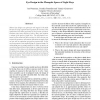Free Online Productivity Tools
i2Speak
i2Symbol
i2OCR
iTex2Img
iWeb2Print
iWeb2Shot
i2Type
iPdf2Split
iPdf2Merge
i2Bopomofo
i2Arabic
i2Style
i2Image
i2PDF
iLatex2Rtf
Sci2ools
ICCV
2003
IEEE
2003
IEEE
Eye Design in the Plenoptic Space of Light Rays
Natural eye designs are optimized with regard to the tasks the eye-carrying organism has to perform for survival. This optimization has been performed by the process of natural evolution over many millions of years. Every eye captures a subset of the space of light rays. The information contained in this subset and the accuracy to which the eye can extract the necessary information determines an upper limit on how well an organism can perform a given task. In this work we propose a new methodology for camera design. By interpreting eyes as sample patterns in light ray space we can phrase the problem of eye design in a signal processing framework. This allows us to develop mathematical criteria for optimal eye design, which in turn enables us to build the best eye for a given task without the trial and error phase of natural evolution. The principle is evaluated on the task of 3D ego-motion estimation.
Computer Vision | ICCV 2003 | Light Ray Space | Natural Evolution | Natural Eye Designs | Optimal Eye Design | Signal Processing Framework |
| Added | 15 Oct 2009 |
| Updated | 15 Oct 2009 |
| Type | Conference |
| Year | 2003 |
| Where | ICCV |
| Authors | Cornelia Fermüller, Jan Neumann, Yiannis Aloimonos |
Comments (0)

